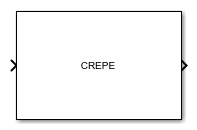CREPE
Libraries:
Audio Toolbox /
Deep Learning
Description
The CREPE block leverages a pretrained convolutional neural model to estimate pitch from an audio signal. This block requires Deep Learning Toolbox™.
Examples
Ports
Input
Output
Parameters
Block Characteristics
Data Types |
|
Direct Feedthrough |
|
Multidimensional Signals |
|
Variable-Size Signals |
|
Zero-Crossing Detection |
|
References
[1] Kim, Jong Wook, Justin Salamon, Peter Li, and Juan Pablo Bello. “Crepe: A Convolutional Representation for Pitch Estimation.” In 2018 IEEE International Conference on Acoustics, Speech and Signal Processing (ICASSP), 161–65. Calgary, AB: IEEE, 2018. https://doi.org/10.1109/ICASSP.2018.8461329.
Extended Capabilities
Version History
Introduced in R2023a


